HDR (high dynamic range) is a subject that gets a lot of attention, both positive and negative, within the photography community. Because the topic can be so polarizing it seems like there are many myths or misunderstandings surrounding HDR photography. In this article we’ll take a look at nine common myths and why they are not true.
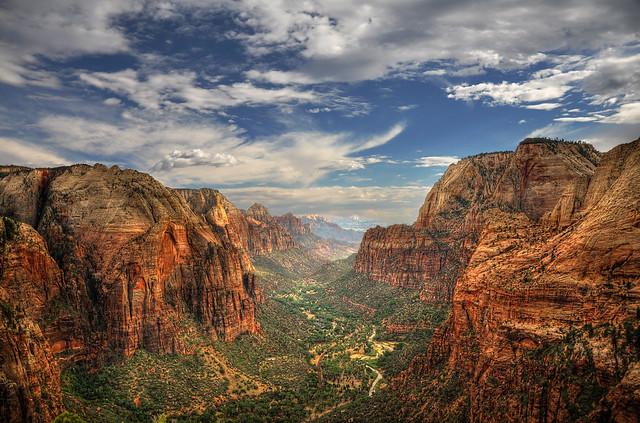
“Zion Canyon HDR” by Ben Jackson
1. HDR is a Way to Take Bad Photos and Make Them Good
If you’ve spent very much time browsing sites like Flickr, 500px, 1X, or any other photo sharing community, you have probably noticed that some HDR photos really jump out at you. Sometimes there is a tendency to think that if you can use HDR to get a more intense image, you can turn average—or even below average—photos into something special like the ones that are catching your eye. The truth is, HDR is not a cure for bad photos. In order to get amazing results you will still need to focus on capturing the best image possible. HDR is one option or approach that is available, but it’s not an easy way to drastically improve the quality of just any photo.
2. HDR is a Fix for Bad Exposure
When processing HDR images you’ll typically work with 3, 5, 7, or maybe even more exposures of the same scene. Sometimes the thought is that since you are bracketing exposures you don’t really need to worry about getting the exposure correct. While it’s true that bracketing can help to reduce the risk of missing the proper exposure, in order to get the best results with HDR you will need to have one shot that is properly exposed, or very close to it, and other bracketed exposures spreading out from there. If you are working with three bracketed exposures and your first one is off, the others will be off as well.
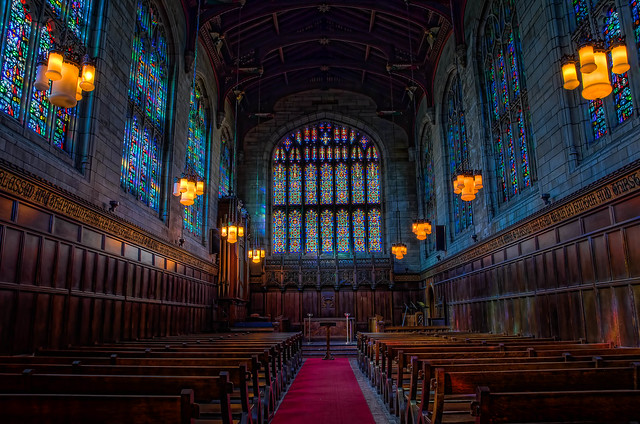
“Bond Chapel” by Rick Seidel
3. HDR Photos Don’t Look Realistic
It’s true that some HDR photos have an extreme and unrealistic look, but this is not the case in every situation. There are plenty of great HDR images that are not obviously HDR, and these tend to have a more realistic look. In some cases HDR processing is used to intentionally create an extreme, grungy, or unrealistic image, but this does not mean that realistic and less extreme results are not possible with HDR. In fact, Photomatix Pro, which is probably the most popular dedicated HDR software, made improvements and enhancements in the latest version to improve the possibilities for getting realistic results.
4. You Need Dedicated Software for HDR
When it comes to processing HDR images there are a number of software options that have been created specifically for this purpose. Some of the leading options include Photomatix Pro, Nik HDR Efex Pro, HDR Merge in Luminar Neo, and HDR Darkroom. If you have been hesitant to try HDR because you don’t want to buy more software you may be surprised to know that there are other options. If you already use Photoshop (CS5 and later) you will have access to HDR Pro, which allows you to merge multiple exposures in Photoshop. You can also do manual exposure blending by using multiple exposures in separate layers and using masks instead of using automated software.
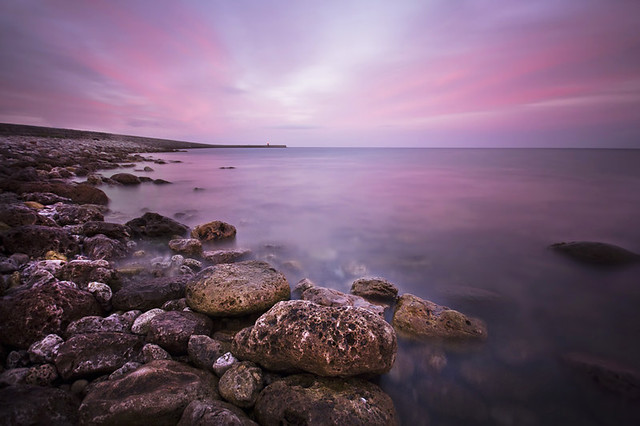
“Pink sunset” by Jimmy McIntyre
5. You Need Multiple Exposures for Each Image
If you didn’t take multiple bracketed exposures of a particular photo you may assume that HDR is not a possibility, but actually you do have a few options. If you are working with a RAW file you could use Lightroom or Camera Raw to create bracketed exposures by increasing and decreasing the exposure of your photo and saving them separately. You can then merge your exposures to create an HDR image. In some cases this will not produce quite as good results as if you had bracketed the exposures in the camera, but you may find that it is a suitable option for some images.
Another option is to use Lightroom or Camera Raw to increase the dynamic range by making adjustments to the shadows and highlights of your image. It is often possible, especially when working with RAW files, to get an HDR-like appearance just by adjusting some settings in Lightroom. You can use HDR presets to accomplish this, or manually adjust the settings like highlights, shadows, whites, blacks, clarity, contrast, vibrance, and saturation.
6. In-Camera HDR Replaces HDR Processing
Some cameras, especially newer models, offer an HDR mode that will process your HDR images right in the camera. The HDR mode will work differently depending on your camera, but generally it will automatically bracket multiple exposures, blend them together in the camera, and save the result as a separate image. This can be an easy way to get started with HDR if your camera offers this mode, but it’s not always the best option. Some cameras only save the finished HDR image as a JPG rather than as a RAW file, and some cameras only save the merged/blended HDR image and discard the bracketed exposures. The HDR mode can be a nice way to get started, but depending on your camera it may restrict your options for processing the image. In most cases you will get the best results, and the most flexibility, by processing the image yourself.
7. You Need a High-End Camera for HDR
You don’t need a fancy or expensive camera to get started with HDR. As long as you can manually adjust the exposure of your shots you can create HDR images with your camera. Using the auto bracketing feature on a DSLR can be a nice time saver, but even if your camera does not offer auto exposure bracketing, you can still manually adjust the exposure between each shot to bracket as needed. This will slow you down a little bit, so it may limit the types of scenes that you can capture, but it is certainly possible.
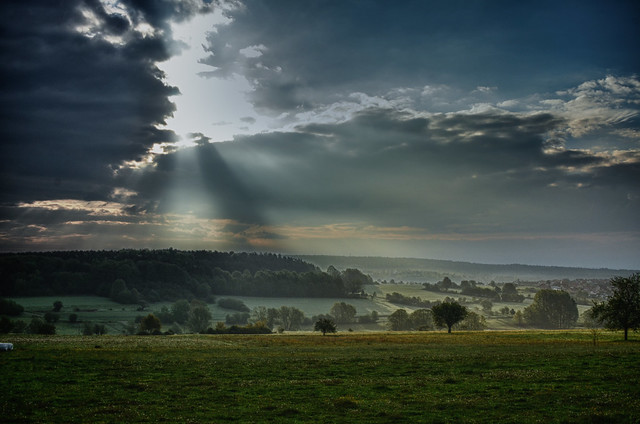
“Morning sun behind the clouds” by Daniel Wehner
8. HDR is Impossible When There is Movement in the Scene
Most HDR merging software includes some sort of ghost removal that helps to deal with objects that move between shots. By using the ghost removal feature you can often deal with small movements that might otherwise cause problems. If you’re dealing with larger or faster movements that cannot be addressed by ghost removal, you can turn to either of the techniques that were mentioned in point number five: 1) creating multiple exposures from the same shot and then blending, or 2) using Lightroom or Camera Raw to increase the dynamic range and process a single image.
9. You Must Either Love or Hate HDR
Because HDR can be such a polarizing topic, it often feels like you have to either love it or hate it. Some photographers are viewed as “HDR photographers” rather than just photographers. You don’t need to have a strong love or hate for HDR. Be open to using HDR when it’s appropriate and you will find that it can improve the quality of your photos even if you lean toward a more conservative use. And don’t feel like you have to force every photo into being HDR.
What’s Your Opinion of HDR?
Please feel free to share your own thoughts in the comments.
About the Author:
Marc Andre is the editor of PhotographyPlanet, a website that offers downloadable products like Photoshop actions, Lightroom presets, photo overlays, textures, and print templates.
Like This Article?
Don't Miss The Next One!
Join over 100,000 photographers of all experience levels who receive our free photography tips and articles to stay current:





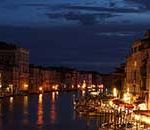
I think HDR photos are in sharper focus than a single exposure…Julian
I do what I consider realistic HDR landscapes, especially sunrises and sunsets over water, with reflections. I used Photomatix for 5 years and have been using Skylum’s Aurora HDR for about a year now. I love it and a major upgrade is on the way October 4th. I was amused that this software was not mentioned in the article but an ad for Aurora HDR was in my email version at the end of your piece. I agree with most everything you said. I’ve worked very hard at keeping my work realistic and then adding just a little bit more punch to the recipe to make my photos stunning. Nice work.
I consider HDR to be another tool or resource to improve artistically or technically a photo. There shouldn’t be such a nonsense concepts as to love or hate it, it’s a feature that can be used by anyone if wished. Personally, I never used it, but once when taking real estate and architectural pictures, I found it useful, because before use it I had to take separate shots of the same scene by tweaking first the different exposures I needed (I didn’t use auto-bracketing, what a dumb!!!). So now, I set HDR with the wished auto-bracketing and voila… Done!
So, my point is that everything depends on the photographer what he/she wishes to be conveyed in the final picture.
Excellent article! Thank you!
My was a long explanation too :-)))
Hi everyone
I’m in the World photography for over 12 years and I did not want to participate before in this discussion because I have always thought, that it is a waste of time. For me everyone shoulds do what he wants, if that makes him happy. It is the first time that I participate in a Forum. I always read in those discussions long liturgies and big explanations for and against the HDR. Now, for first time, I will try to explain what I think. For me the case is very simple:
1. Do what you want if you like it. If you like the HDR, if you fell good and happy wiht them, then just do it. It’s valid ! It’s the most important !
2. Any Camera and any Handy of the accurately Markt records faithfully, truly the reality. Not even our own eyes. The colors spectrum, tonalities, the lighting and the depth (we live in a 3D world) on the cameras and another digital equipments, vary from brand to brand (sRGB IEC61966-2.1, Adobe RGB, etc.).
3. A photo does not have necesary to be realistic. There are many specialties and trends in the Art of photography. If somebody wants “realistic” photos or wants to take them more adjusted to the reality, then shoulds be dedicated to the Photo-Journalism. But landscaping and other specialties of the photography DO NOT NECESSARILY have to be conditioned 100% to the “reality”.
4. A good photographer does not need HDR and no other editing software to make good photos. Remember, anyone takes photos, but not everyone is a photographer.
If according to my opinions you think that I edit my photos, or that I work with softwares or I use HDR, then you are wrong :-) My works do not contain any retouching, any revised editions or arrangements by computer (no photoshop, no HDR). I do not edit the photos on the camera. I never edit my pictures. I work only with the camera before the shot. I do not use polarized filters on the lenses.
I invite you to see my work: http://www.juanrubiano.com or https://www.flickr.com/photos/juanflauta/
Many greetings !
Juan Rubiano
Sorry for my very bad English :-)
Very informative article Marc. My preferred software is Dynamic HDR. I have used Photoshop at times but find it a little less appealing.
I do not profess to be an expert on HDR or photography for that matter, so I will not comment on the previous discussions. I use HDR for my own satisfaction. I understand that there is a fine line between what looks realistic and what is not and it is easy to cross that line “for that little bit of extra contrast/colour etc”.
Our craft is a very subjective one and what works for one person could be a no no for another.
I have been using Photomatix Pro for a few years now, every so often I will leap over the cliff into the HDR hole, mainly because of the effect I’m after. I have a few personal saved presets which I use to enhance my favourite photography subjects, derelict houses and machinery, these are quite grungy and dark, which is the effect I’m after. I do occasionally use the software for its intended purpose and definitely go for a more subtle end result with these.
Oh, and I totally agree with myth 7, my very first attempts all those years ago were taken on a Sony point and shoot.
Even with a “realistic” HDR, the feeling is always unrealistic because we put the whole range of detailed shadows and highlights in such a manner so different of the human eye/brains will see and interprete.
We can see in a blink a dynamic range of 14EV, With the adaptive possibility of our eyes it goes as far as 24 EV. A HDR image tries to cover more than a 14EV dynamic range, so we automatically see the image as an unrealistic one.
When HDR came up in the beginning I felt thrown back in t he psychedelic era of the sixties and seventies. In that period it was a hype (like pokemon today). Finally we got back to a photorealistic image where HDR helped us to improve some parts like we did in the analogue period with dodging and burning.
90% of HDR hate is in reality envy
>:-)
people tend to see identify HDR as the over-saturated unnatural images, but there’s way way more
Must say i disagree with Dan and Srihari. HDR is basically nothing more than an advanced tool for controlling shadows and highligts. This can be done in a nonrealistic way for sure, but it can also be used in a realistic way, if you know what to do. In some situations it can be a great tool for controlling dynamic range in a photo while preserving the mood of a landscape. If the dynamic range in a landscape is low HDR is never needed, since all corrections can be created from a single exposure with LR or PS sliders or curves. Remember though, that highlights, shadows and clarity sliders, can destroy realism in a photo too. In motives with a high dynamic range, HDR might be (but isnt always) needed to create a realistic picture. Using the presets in Photomatix is NOT the realistic way to do it. They are all unrealistic. Basically its all about using your eyes and evaluating what you do when processing, which is no different from when processing using LR sliders or curves.
Added a link to an image that IMO is closer to the realistic approach than the photos from the article. It is a HDR from 9 exposures if i remember correct.
http://naturephotos.dk/NaturePhotos_show_pic_ejergalleri.php?kgf=12937&art=0&menu=1&_Ejer=7&sort=&Kat=1&start=31
I do not understand what the problem with HDR, is a technique that is not real, that what the other. then there should exist black white, or painting with all its variants. is like asking that there were different ethnicities or religions, we live in a varied diversity and freedom of expresones, tastes, religions world, pensamientos.que everyone is inclined to or want, period.
Point #7 – I first tried HDR photography with my little point and shoot Canon Powershot SX120 – got great results, proving again, that it’s not the equipment (yikes, wanted to edit that because it sounds arrogant) but you folks know what I mean – you don’t need a top of the range camera to achieve HDR successfully.
HDR photos do not look realistic. That is not a myth. Leaving it in your article makes defense of HDR quite weak.
The fundamental premise I keep hearing about HDR is that it goes beyond what the camera sees, since the camera can only see 3 out of 9 zones at a time or something to that effect.
Well, look at the images, even the ones in your article. Is this really how your eye would see a single image, with colors bleeding everywhere and a kind of sharpness that is unnatural?
3 HDR does not look realistic; I am waiting to see a HDR shot that looks close to realistic. It does not seem to matter what the skill level of the HDR tech is, they all have issues with being unreal, or surreal. In the later I think that is good if you are shooting surrealistic shots, but the first is a major draw back.
If I want a more depth, detail, or higher compensation shot, I’ll use tone mapping before I would use HDR. The depth of color, image (can actually look more 3d than HDR), and other effects are a lot more real.
When I was shooting film I used the technique to make up for the fact that chrome film was not able to span the dynamic range of images I needed to make especially in architecture. For interiors that meant frequently hauling in 200 pounds of lights.
Digital offers many freedoms from those days. Multiple exposures, layering, masking, etc. But the best thing for me so far is the ability of Lightroom and newer photoshops to deal with a 32 bit floating point Tif comprised of any number of exposures offering 15 or more stops of latitude in one photo.
Photomatix is better than it used to be but still there is that urge to make a cartoon out of things.
HDR has opened a whole new world for me. The results can be breathtaking. Combining exposures in the “digital darkroom” and then doing dodging and burning along with other artistic adjustments in Photoshop truly make for stand out images that would otherwise be just another snapshot. I urge everyone to at least try a few HDR shots and then judge for themselves.
As the wise old adage says, “Don’t knock “til you try it”. I think you will be amazed at the results that can be achieved.
However, just remember that HDR does NOT replace basic photographic techniques including proper exposure, shutter speed, subject selection, and above all COMPOSITION. For those interested in finding out more about HDR, I highly recommend one of the sites run by Blake Rudis. Here is one of the links, the one that got me started.
https://www.everydayhdr.com/tutorials/
Enjoy….